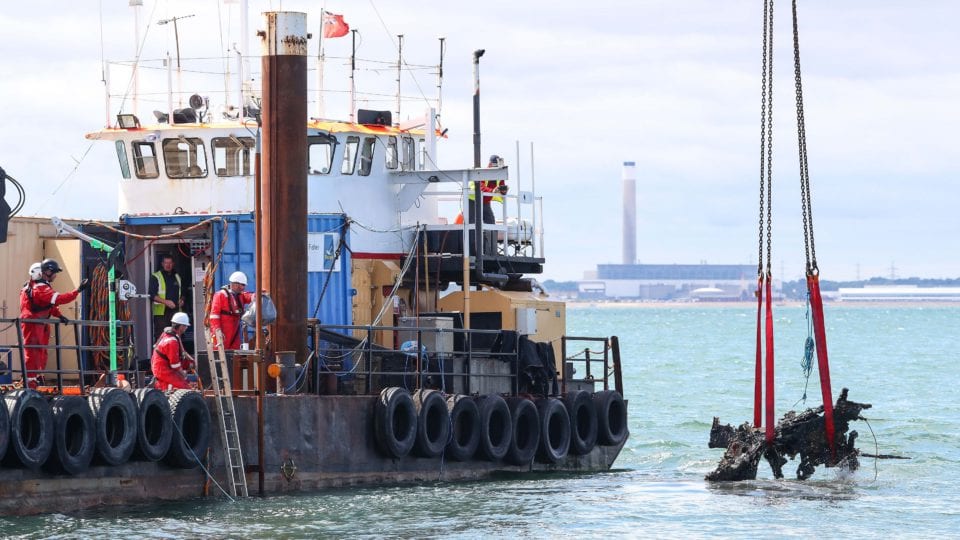Second World War aircraft discovered by National Grid engineers
A Second World War aircraft has been recovered from the seabed 500m off the Portsmouth coast after being discovered by National Grid engineers.
6th June 2019 by Networks

This week, specialist divers and archaeologists completed an operation to retrieve the wreckage of a 1943 Fairey Barracuda Torpedo Bomber (believed to be No. BV739) – just in time for the 75th anniversary of D-Day.
The three-seater plane, part of 810 Squadron Royal Navy Air Station, based at Lee-On-Solent is believed to have got into difficulty shortly after taking off for its test flight before crashing 500m from the coast in Portsmouth.
It was found by National Grid engineers last summer during a seabed survey ahead of the construction of new subsea electricity cable between England and France.
The cable, called an interconnector, will be buried in the seabed and will stretch for 240km between Fareham, Portsmouth and Normandy, France and deliver energy for UK consumers.
The Interconnexion France-Angleterre 2 (IFA2) is National Grid’s second electricity subsea interconnector to France and is a joint venture with French System Operator RTE. Once live, it will provide an additional 1GW of capacity – enough electricity to power a million homes and play a vital role in decarbonising the UK’s energy system.
The Barracuda wreckage is the only one to have ever been found in one piece and the last remaining aircraft of its kind in the UK.
David Luetchford, Head of IFA2 for National Grid said: “Interconnectors are about bringing us closer to a zero-carbon future, but we must also respect the past. An important part of our job is to always have a thorough and sympathetic approach to archaeological finds. Over the course of the project we’ve inspected over 1,000 targets of interest, many of which were found to be unexploded ordnance, not unusual given the history of this location. However, to have found a 1943 Fairey Barracuda torpedo bomber is incredible and such a key piece of British history.
“It’s not every day you get the chance to play a role in an operation like this and it is very lucky to have found the plane in such a small search area. We surveyed a 180-metre-wide area along the cable route and if we had chosen a slightly different route, there is a good chance the plane would never have been found.”
Work to fully retrieve the plane is expected to take around three weeks in total as experts from Wessex Archaeology are carefully excavating the area around the aircraft and removing large amounts of silt and clay.
So far, one of the wings has successfully been lifted out of the waters and work on the second is currently underway. The remainder of the plane will be recovered by lifting it in sections over the coming days.
Wessex Archaeology lead archaeologist Euan McNeil said: “Our team has been working closely with all those involved to ensure that any risks to heritage assets on the seafloor are mitigated. This aircraft is a rare find and a fantastic opportunity to understand more about a piece of wartime technology.
“We have been undertaking the excavation under a licence from the MoD, and it has taken careful planning to ensure that we lift the remains and any associated material which may have been scattered as it sank – without causing its condition to deteriorate significantly. This has involved excavating the silt around the plane and sieving it for artefacts, then carefully dividing the remaining structure into manageable sections for lifting.
“The recovery of the Fairey Barracuda will aid an ongoing Fleet Air Arm Museum project to recreate what will be the world’s only complete example of this type of aircraft. This will give us a chance to examine a unique lost piece of aviation history.”
Once retrieved, the parts will be taken to the Royal Navy Fleet Air Arm Museum in Somerset where it will be studied and used to rebuild a full-size Barracuda in the site’s aircraft hangar.
The plane’s pilot has been named as Sub Lt DJ Williams who managed to escape the crash and survived WW2.
The team at Wessex Archaeology are currently trying to trace him and his family.
The Interconnexion France-Angleterre 2 (IFA2) is National Grid’s second electricity subsea interconnector to France and is a joint venture with French System Operator RTE. Once live, it will provide an additional 1GW of capacity – enough electricity to power a million homes and play a vital role in decarbonising the UK’s energy system.
Comments
Login on register to comment
Related content

Power
The future for vegetation management
Why networks should focus on data not trees to overcome the costly challenges involved in vegetation management

Power
An unprecedented opportunity for change
Why short interruptions will matter in RIIO-ED2 and how to address them.

Power
Time for less talk and more action on decarbonisation
Core "oven-ready" solutions to decarbonising heat and transport exist today and should be implemented without delay, says WPD's future power networks expert.
Related supplier content

Power
Load patterns and lockdown: how Covid-19 is impacting electricity networks
Insights into dynamics on the low voltage network as the outbreak unfolds

Downloads
Protect electrical equipment from insulation failure
Insulation faults are a major cause leading to the eventual failure of electrical equipment. Partial discharge (PD) is a very reliable indicator of developing insulation faults. Regular PD testing allows users to detect and analyze PD activity

Heat
How E.ON. is helping the City of London become a zero emissions city
Discover Citigen. Deep in the heart of our bustling capital